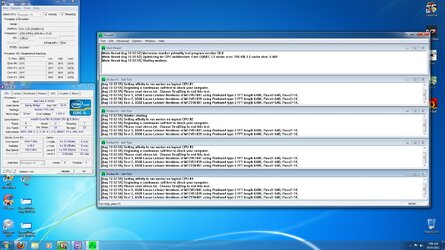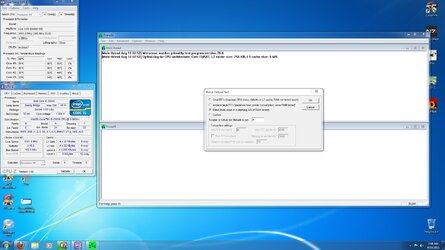- Joined
- Dec 4, 2008
Enthusiatic as I am as a member of ours proud OCF benching team, I'm also on the "green side".
I like to overclock and maximize energy as the same time.
I have a new processor and done toying around a bit. Too bad, it couldn't do any higher than 51x
So now it's going to be a 24//7 machine replacing my current i5-750.
Interestingly, while I was looking for an optimal setting for this chip and learning more about Multi Load Line Calibration functionality. I also found various energy consumption associated with it.
Previously, I've tested at various ranges of 4.40GHz~4.70GHz which I found to be the best clocks for i5-2500k and i7-2600k as far as speed, energy consumption and temperature ideally for my usage. I would like to note that every chip is difference. Your milage may vary.
===========
===========
===========
I'm using underload wPrime1024M and Kill-A-Watt EZ as a method to measure energy used for a whole system.
Passing wPrime1024M, Prime95 sFFTs for 20 minutes and Cinebench R11.5 considered stable of this testing.
(notice Prime95 pulls the highest wattage)
CPUz and CoreTemp, HWM Pro do not report voltages correctly. Gigabyte's Touch BIOS pc status monitor works fine.
SYSTEM hardwares with peripherals connected:
Win7 x64 - NO TWEAKS -Fully updated and loaded with programs including antivius security.
Gigabyte Z68X UD3H B3
8GB (2x4GB) G.Skill 1600MHz
Frio with dual Cooler Master PWM 120mm LED rifle bearing fans
(original Frio's fans removed due noisiness even at its lowest speed adjusted)
1- 92mm PWM fan for chipset cooling
1- Seagate 1.5TB Sata III / AHCI mode
1- DVD drive
1- USB multi-card reader
1- PCI Wifi
1- 18 LEDs light bar
(using IGP Intel's HD 3000 - without discreet GPU)
STEP 1:
I've choosen 4.5GHz as a final 24/7 clock as follows (so I thought...)
ENABLED 4 energy saving features (C1E, C3/C6, EIST and Intel Thermal Monitor)
DISABLED Multi Load Line Calibration
1.360 Vcore (this much needed to pass wPrime 1024M)
1.150 QPI/VTT
1.100 Graphic Core
1.815 CPU PLL
1.510 DRAM
888-24 1T Turbo Performance
28-27-29-29C IDLE 65 watts
54-56-57-56C LOAD 149 watts
It passed wPrime1024M with flying colors....but fail Prime95
STEP 1 1/2:
Level 10 LLC ENABLED......Pass and stable...but I forgot to take notes.
STEP 2:
Next, I've dropped vcore down to 1.330 but kept LLC at level 10 (other settings were kept the same)
Voila! It was still good and stable....but I've noticed it was hogging 191 watts on the register.
That's an extra 42 watts for level 10 LLC enabled with lower vcore was used. That's too much.
STEP 3:
Next, kept vcore at 1.330 and dropped LLC at level 5 (other settings were kept the same)
Voila! It was still good and stable. It now consumes only 169 watts which reduced by 22 watts.
It's in fact comsumes less energy with LLC reduction.
STEP 4:
Further reduction of vcore to 1.300 and kept level 5 for LLC = Pass everything OK
It registered 162 watts. That's only 7 watts less than STEP 3 above. (Prime95 sFFTs pulls 185 watts)
So, LLC plays a bigger role of energy consumption that I've notice here.
(Any lower vcore would fail. A combination of lower than 1.30 vcore with level 10 LLC did not help. BSOD)
OK, what's all this tell me?
1- Lower VCORE can be used if LLC was enabled. It helps with stability.
2- Lower VCORE setting does not neccessarily mean lower energy consumption if LLC was enabled.
2- Too much of higher level of LLC applied can be energy wasteful.
For now I'm enjoying a whisper quiet open air system at 4.5Ghz energy efficient.
Dual PWM fan on the Frio lugs around 1100~1200rpm surfing until duty calls.
92mm PWM fan lugs around 800~900rpm noiselessly.
=========
=========
Finalized settings for 4500MHz
45x
ENABLED 4 energy saving features (C1E, C3/C6, EIST and Intel Thermal Monitor)
ENABLED Multi Load Line Calibration at Level 5
1.300 Vcore
1.150 QPI/VTT
1.100 Graphic Core
1.815 CPU PLL
1.510 DRAM
888-24 1T Turbo Performance
wPrime 1024M
30-30-32-32 IDLE 65 watts
56-59-59-60 Peak - LOAD 162 watts
Prime95 sFFTs
29-29-31-31C IDLE 65 watts
61-65-66-66C Peak - LOAD 185 watts
You'll be amazed how much heat and energy consumed when comparing this with a Q6600 clocked at 3.80GHz.


==========
==========
==========
Also, I found this setting to be optimal for my chip at 4700MHz saved into user's profile setting just incase I ever needed with a few mouse flicks.
47x
ENABLED 4 energy saving features (C1E, C3/C6, EIST and Intel Thermal Monitor)
ENABLED Multi Load Line Calibration at Level 5
1.380 Vcore
1.270 QPI/VTT
1.130 Graphic Core
1.830 CPU PLL
1.510 DRAM
888-24 1T Standard Performance
wPrime 1024M
31-30-32-32C IDLE 68 watts
61-64-64-63C Peak - LOAD 185 watts
Prime95 sFFTs
31-29-31-31C IDLE 68 watts
67-72-72-72C Peak - LOAD 214 watts


===========
===========
===========



At the moment, I can not recommend this Gigabyte Z68X UD3H B3 motherboard to anyone.
It's having a problem with woken up from sleep mode to have the overclocked turbo mulitplier automacially resetted back to 34 or 35x as reported by a few members here on OCF and on Gigabyte's Forum as well.
I like to overclock and maximize energy as the same time.
I have a new processor and done toying around a bit. Too bad, it couldn't do any higher than 51x
So now it's going to be a 24//7 machine replacing my current i5-750.
Interestingly, while I was looking for an optimal setting for this chip and learning more about Multi Load Line Calibration functionality. I also found various energy consumption associated with it.
Previously, I've tested at various ranges of 4.40GHz~4.70GHz which I found to be the best clocks for i5-2500k and i7-2600k as far as speed, energy consumption and temperature ideally for my usage. I would like to note that every chip is difference. Your milage may vary.
===========
===========
===========
I'm using underload wPrime1024M and Kill-A-Watt EZ as a method to measure energy used for a whole system.
Passing wPrime1024M, Prime95 sFFTs for 20 minutes and Cinebench R11.5 considered stable of this testing.
(notice Prime95 pulls the highest wattage)
CPUz and CoreTemp, HWM Pro do not report voltages correctly. Gigabyte's Touch BIOS pc status monitor works fine.
SYSTEM hardwares with peripherals connected:
Win7 x64 - NO TWEAKS -Fully updated and loaded with programs including antivius security.
Gigabyte Z68X UD3H B3
8GB (2x4GB) G.Skill 1600MHz
Frio with dual Cooler Master PWM 120mm LED rifle bearing fans
(original Frio's fans removed due noisiness even at its lowest speed adjusted)
1- 92mm PWM fan for chipset cooling
1- Seagate 1.5TB Sata III / AHCI mode
1- DVD drive
1- USB multi-card reader
1- PCI Wifi
1- 18 LEDs light bar
(using IGP Intel's HD 3000 - without discreet GPU)
STEP 1:
I've choosen 4.5GHz as a final 24/7 clock as follows (so I thought...)
ENABLED 4 energy saving features (C1E, C3/C6, EIST and Intel Thermal Monitor)
DISABLED Multi Load Line Calibration
1.360 Vcore (this much needed to pass wPrime 1024M)
1.150 QPI/VTT
1.100 Graphic Core
1.815 CPU PLL
1.510 DRAM
888-24 1T Turbo Performance
28-27-29-29C IDLE 65 watts
54-56-57-56C LOAD 149 watts
It passed wPrime1024M with flying colors....but fail Prime95
STEP 1 1/2:
Level 10 LLC ENABLED......Pass and stable...but I forgot to take notes.
STEP 2:
Next, I've dropped vcore down to 1.330 but kept LLC at level 10 (other settings were kept the same)
Voila! It was still good and stable....but I've noticed it was hogging 191 watts on the register.
That's an extra 42 watts for level 10 LLC enabled with lower vcore was used. That's too much.
STEP 3:
Next, kept vcore at 1.330 and dropped LLC at level 5 (other settings were kept the same)
Voila! It was still good and stable. It now consumes only 169 watts which reduced by 22 watts.
It's in fact comsumes less energy with LLC reduction.
STEP 4:
Further reduction of vcore to 1.300 and kept level 5 for LLC = Pass everything OK
It registered 162 watts. That's only 7 watts less than STEP 3 above. (Prime95 sFFTs pulls 185 watts)
So, LLC plays a bigger role of energy consumption that I've notice here.
(Any lower vcore would fail. A combination of lower than 1.30 vcore with level 10 LLC did not help. BSOD)
OK, what's all this tell me?
1- Lower VCORE can be used if LLC was enabled. It helps with stability.
2- Lower VCORE setting does not neccessarily mean lower energy consumption if LLC was enabled.
2- Too much of higher level of LLC applied can be energy wasteful.
For now I'm enjoying a whisper quiet open air system at 4.5Ghz energy efficient.
Dual PWM fan on the Frio lugs around 1100~1200rpm surfing until duty calls.
92mm PWM fan lugs around 800~900rpm noiselessly.
=========
=========
Finalized settings for 4500MHz
45x
ENABLED 4 energy saving features (C1E, C3/C6, EIST and Intel Thermal Monitor)
ENABLED Multi Load Line Calibration at Level 5
1.300 Vcore
1.150 QPI/VTT
1.100 Graphic Core
1.815 CPU PLL
1.510 DRAM
888-24 1T Turbo Performance
wPrime 1024M
30-30-32-32 IDLE 65 watts
56-59-59-60 Peak - LOAD 162 watts
Prime95 sFFTs
29-29-31-31C IDLE 65 watts
61-65-66-66C Peak - LOAD 185 watts
You'll be amazed how much heat and energy consumed when comparing this with a Q6600 clocked at 3.80GHz.


==========
==========
==========
Also, I found this setting to be optimal for my chip at 4700MHz saved into user's profile setting just incase I ever needed with a few mouse flicks.
47x
ENABLED 4 energy saving features (C1E, C3/C6, EIST and Intel Thermal Monitor)
ENABLED Multi Load Line Calibration at Level 5
1.380 Vcore
1.270 QPI/VTT
1.130 Graphic Core
1.830 CPU PLL
1.510 DRAM
888-24 1T Standard Performance
wPrime 1024M
31-30-32-32C IDLE 68 watts
61-64-64-63C Peak - LOAD 185 watts
Prime95 sFFTs
31-29-31-31C IDLE 68 watts
67-72-72-72C Peak - LOAD 214 watts


===========
===========
===========



It's having a problem with woken up from sleep mode to have the overclocked turbo mulitplier automacially resetted back to 34 or 35x as reported by a few members here on OCF and on Gigabyte's Forum as well.
Last edited:
















 ) Not sure why I'm seeing totally different behavior. I'm currently running these settings:
) Not sure why I'm seeing totally different behavior. I'm currently running these settings:




